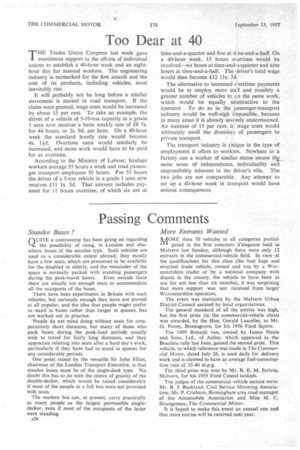Passing Comments
Page 28

Page 29

If you've noticed an error in this article please click here to report it so we can fix it.
Standee Buses ?
QUITE a controversy has been going on regarding the possibility of using, in London and elsewhere, buses of the standee type. Sueh vehicles are used to a considerable extent abroad; they mostly have a few seats, which are presumed to be available for the disabled or elderly, and the remainder of the space is normally packed with standing Passengers during the peak-travel hours. Even outside these there are usually not enough seats to accommodate all the occupants of the buses.
There have been experiments in Britain with such vehicles, but curiously enough they have not proved at all popular, and the idea that people might prefer to stand in buses rather than longer in queues, has not worked out in practice.
People 'do not mind doing without seats for comparatively short distances, but many of those who pack buses during the peak-load periods usually wish to travel for fairly long distances, and they appreciate relaxing into seats after a hard day's work, particularly if they have had to stand in queues for any considerable periods.
One point raised by the versatile Sir John Elliot, chairman of the London Transport Executive, is that standee buses must be of the single-deck type. No doubt this has to do with the centre of gravity of the double-decker, which would be raised considerably if most of the people in a full bus were not provided with seats.
The modern bus can, at present, carry practically as many people as the largest permissible singledecker, even if most of the occupants of the latter were standing.
A26
More Entrants Wanted
MORE than 70 vehicles in all ,categories participated in the first concours d'elegance held in Malvern last Sunday, although there were only 12 entrants in the commercial-vehicle field. In view of the qualifications for this class (the best kept and smartest trade vehicle, owned and run by a Worcestershire trader or by a national company with depots in the county, the vehicle to have been in use for not less than six months), it was surprising that more support was not received from larger Worcestershire operators.
The event was instituted by the Malvern Urban District Council assisted by local organizations.
The general standard of all the entries was high, but the first prize (in the commercial-vehicle class) was awarded, by the Hon. Gerald Lascelles, to Mr. G. Povey, Bromsgrove, for his 1956 Ford Squire.
The •1909 Renault van, owned by James Neale and Sons. Ltd., of Astley, which appeared in the Beaulieu rally last June, gained the second prize. This vehicle, to which reference was made in The Commercial Motor, dated July 26, is used daily for delivery work and is claimed to have an average fuel-consump
tion rate of 35-40 m.p.g. '
The third prize was won by Mr. R. E. M. Scrivin, Malvern, for his 1955 Ford Consul taxicab.
The judges of the commercial vehicle section were: Mr. R. J. Buckland, Civil Service Motoring Association; Mr. P. Crichton, Birmingham area road manager of the Automobile Association and Miss M. C. Strangemari,.The Commercial Motor.
It is hoped to make this event an annual one and that more entries will be received next year.
Psychology in Telephoning
AN idea for saving time while making telephone
calls and with the object of establishing more personal relations between those who call and those who receive has been adopted by the Croft Bodybuilding and Engineering Co., Ltd., of GaIlowgate, Leicester. It is embodied in a folder entitled "Who's Who at Croft," which is broadcast to potential and distant clients.
The Croft " team" is listed and there are six thumbnail pictures showing departmental chiefs, with details of their spheres of authority. The managing director of the company, Mr. A. T. Kevan Murray, states in a foreword to the folder, that it is exasperating to be kept Waiting on the telephone to discover who should be consulted about a problem in hand. He believes that the folder will reduce time lost in this way, whilst if an inquirer has a mind picture of the person at the other end of the telephone, this makes for easier and more friendly negotiations.
Perhaps one day some improved and cheaper method of seeing a living picture of those to whom we speak on the telephone will come into greater.use, hut in the meantime this seems quite a clever way of improving contact.
India Tyres on Television
nNE of the foremost companies in Scotland, the India Tyre and Rubber Co., Ltd., were well to the fore as the first advertisers to appear on the new Scottish I.T.V.
The two-minute documentary-type commercial, which was of a dignified nature, was filmed by Scottish Television, Ltd., partly on location on Clydeside and partly in the studio. The commentator was Duncan Lamont, the well-known Scottish actor.
Many of the workers of the India concern, were " shot" as they were leaving _the factory and, later, saw themselves on the screen.
The negotiations for this opening event were carried out within a matter almost of minutes of the television contractor being appointed.




























































































